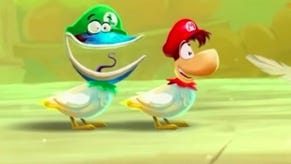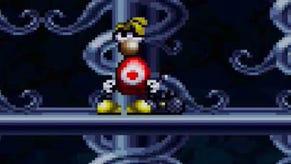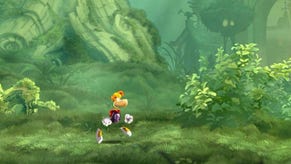Next-Gen Face-Off: Rayman Legends
Xbox One, PlayStation 4 - or Wii U?
Featuring beautifully drawn 2D visuals and imaginative gameplay, Rayman Legends stands out as one of the best games released last year, showing that the humble 2D platformer still has much to offer amongst a sea of blockbuster first-person shooters and open world action titles. It's also one of the few games to deliver native 1080p visuals running at a smooth 60fps - an impressive feat rarely seen on the previous generation of consoles, and something which both the PS4 and Xbox One are struggling to achieve in an era where pushing prettier pixels on screen is still considered to be more important than targeting high frame-rates.
Ubisoft's decision to port Rayman Legends to the PS4 and Xbox One is a somewhat curious choice then, given that the title already delivers a solid 1080p60 experience on last-gen systems - with the existing art looking suitably crisp and clear, there's little to suggest a need for graphical overhaul. Instead, the decision to bring the game over to the next-gen consoles seems to have more to do with maximising the title's potential audience and revenue stream, as opposed to delivering a dramatic leap forward in visual quality. That said, Ubisoft is promising a few refinements with the next-gen versions of Rayman Legends, including faster loading times and the use of uncompressed textures across the game's 3D models. But are the changes worth upgrading for, and has anything been done to take advantage of the PS4 and Xbox One's unique features in the form of the Dual Shock 4's touchpad and Kinect's audio and motion sensing abilities?
First impressions reveal that the basic rendering set-up doesn't appear to have changed from the last-gen versions of the game, with Rayman Legends adopting a native 1080p framebuffer on both PS4 and Xbox One without any anti-aliasing on its 3D elements. While the lack of edge smoothing comes across as something of a missed opportunity considering the extra rendering bandwidth and available RAM compared to the 360, PS3, and Wii U, jaggies are never an issue due to the way the predominantly sprite-based artwork is displayed alongside various effects - such as depth of field and bloom.
Alternative comparisons:
"There's not much next-gen consoles can do to improve the 2D rendering, so the result is a game that is mostly identical to the existing versions of Rayman Legends."
- Rayman Legends: PS4 vs. Wii U
- Rayman Legends: Xbox One vs. Wii U
- Rayman Legends: PS4 vs. PC
- Rayman Legends: Xbox One vs. PC
Elsewhere there are no obvious signs of any additional improvements in the already excellent effects work, with elements such as the use of lighting, particles and depth of field matching up across all platforms equally. Curiously, the use of uncompressed textures in the 3D models fails to meaningfully stand out on the PS4 and Xbox One releases: the core artwork is similarly crisp across all versions of Rayman Legends, although in brighter scenes the edges of some texture detail does appear a tiny bit sharper on the PS4 and Xbox One.
Instead, the varying gamma set-up and contrast settings between platforms have a more noticeable effect with regards to the amount of sharpness and visible detail in any given scene, with the 360 subtly crushing the darkest details on screen. The difference in install sizes between the two platforms is also interesting (4.3GB on Xbox One and 9GB on PS4) and we can't help but wonder whether the Xbox One version features the uncompressed assets at all. Regardless, whatever the explanation may be, the visual differences across all the versions we've tested to date are minimal to non-existent.
All versions of the game are very closely matched on raw visual terms, but loading times are dramatically improved over last-gen console and PC, being virtually non-existent on the PS4 and Xbox One. As a result, the interactive loading screens found in the other versions of Rayman Legends are removed entirely and the distinct lack of any breaks in moving in between the hub world and individual levels delivers a more seamless experience than before without any momentary distractions away from the core gameplay.
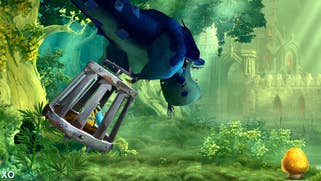

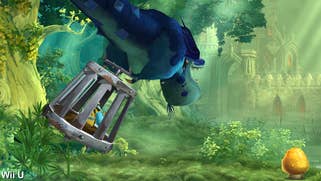
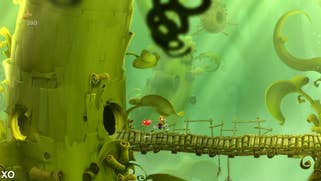
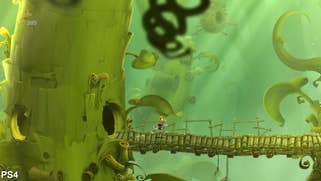



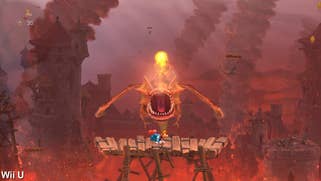

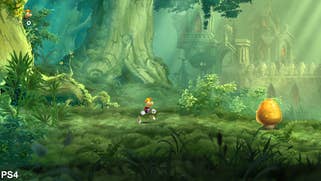
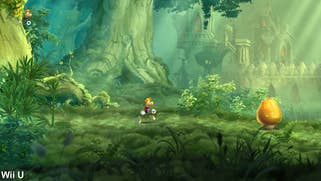
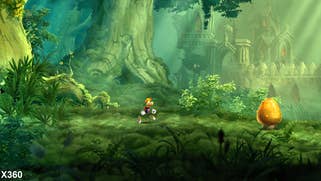
In terms of performance Rayman Legends runs solidly at 60fps without dropping a single frame, even during boss battles and hectic gameplay segments, where the engine is pushing a range of animated sprites, effects, and 3D elements on-screen. The combination of beautifully drawn artwork and fluid animation is simply gorgeous to look at, while the rock solid controller response feels crisp and perfectly suited to handling the fast-paced stages where a wrong click of the d-pad often leads to an early demise.
Both next-gen controllers also handle the action well, with the Xbox One's overly clicky d-pad never missing a beat in tense segments of gameplay. The Dual Shock 4 works just as well, if not better, given the prime positioning of the d-pad for 2D-based gameplay and what we would consider as a more comfortable feel for the controller in general.
Unlike the Wii U version - where large portions of the game are tailored around the GamePad's touch screen and gyroscope inputs - special features unique to the PS4's Dual Shock 4 are kept to the minimum - in this case using the touch pad is limited to selecting camera mode. This allows you to pause the game, zoom and pan around the exceptional artwork, and then share the image with your friends. Xbox One has no such equivalent mode, and no Kinect support either.
Beyond that, the bulk of the console specific bonuses come in the form of uniquely branded character skins. On Xbox One we get outfits based on Splinter Cell and Far Cry 3's main characters (Splinter Ray, Ray Vaas, and Globox Vaas), while PS4 owners get Assassin Ray, parodying the Assassin's Creed franchise. There's also the new Funky Ray character, which is available for purchase on both consoles using Uplay points.
"Rayman Legends on next-gen console matches the locked 1080p60 output of the existing Xbox 360, PS3 and Wii U versions of the game."
Alternative comparisons:
Rayman Legends: the Digital Foundry verdict
Outside of a few new characters and limited use of the touchpad on the PS4's Dual Shock 4, there's no real reason to upgrade to the Xbox One and PS4 versions of Rayman Legends if you already own the game on other formats. Visual upgrades are close to non-existent and the experience is basically the same as the existing PS3, Xbox 360 and PC version of the game. Even the audio remains in stereo - just as it did on all the other versions we've tested. However, if you've yet to take the plunge the PS4 and Xbox One editions offer up a further opportunity to play what was undoubtedly one of the finest games of 2013.
All of which leads us up to an interesting conclusion. Despite the enormous leap in power the new consoles represent, in our opinion it's the Wii U version of Rayman Legends that remains the definitive edition of the game, with the title taking advantage of the GamePad's unique features in ways that genuinely add variety and more fun to the gameplay. Let's not forget that while this game may have been ported to a vast range of different hardware platforms, it started out life as a Wii U exclusive, built around the unique capabilities of the system. Indeed, it's the Nintendo console that offers the experience that the developers originally intended for the game, before the last-minute switch to a multi-platform release.
Meanwhile, the other versions of Rayman Legends each offer up an equally superb experience for those who aren't keen on some of the quirky controller features on the Wii U game. The PS4 and Xbox One editions serve up a tiny slice of extra content in the form of new characters and a barely noticeable bump in texture clarity in some scenes, but these additions aren't worth paying a premium for over the heavily discounted previous versions of the game. Right now Rayman Legends is available online for around £17 on the last-gen consoles and PC, while the PS4 and Xbox One releases command a price premium that is short on delivering much in the way of worthwhile extras.






